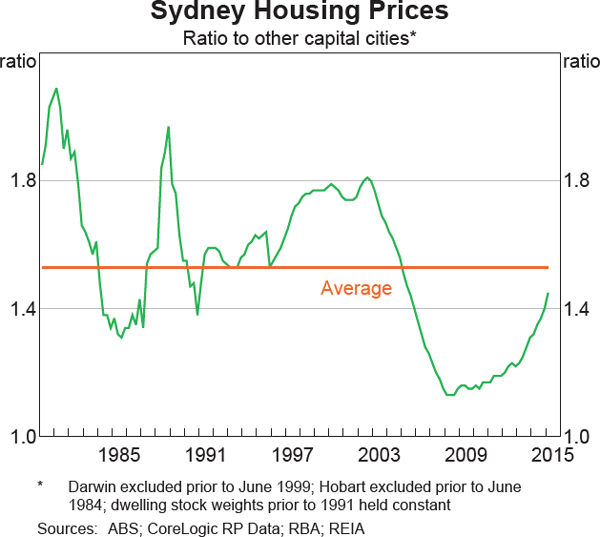Submission to the Inquiry into Home Ownership Drivers of Supply
House of Representatives Standing Committee on Economics
- Download 4.73MB
The supply of housing is a stock. The flow of new construction (including renovation of existing stock) is relatively small compared with the existing stock, so housing supply inevitably moves quite slowly in response to the changing needs of and demand for housing by households. There are a number of aspects of the flow supply of new housing that could be made more flexible. However, the effects of such changes on the flexibility of stock supply would be fairly limited. Housing supply in the stock sense will therefore always be somewhat sluggish. In addition, Australia faces a number of particular challenges stemming from the geographical distribution of its population (RBA 2014b). Australia is highly urbanised and its urban population is unusually concentrated in a few large cities. The population densities of these cities are also quite low relative to those of cities with similar population sizes in comparable countries (Ellis 2013).
Two implications of this pattern of urbanisation work against efforts to provide housing at affordable cost. The first is that housing prices in larger cities tend to be more expensive relative to local incomes, even allowing for the fact that incomes are also generally higher on average in larger cities (Andrews 2001), although the wedge between prices in larger and smaller cities can fluctuate noticeably over long periods (Graph 21). A greater fraction of Australia's population is exposed to these higher big-city housing costs (and enjoy the advantages of larger population centres) relative to the situation in other countries where the population is more dispersed across a larger number of (often smaller) population centres. The second implication is that low-density cities mean that people live further away from central amenities, and it is costly to provide enough transport infrastructure to make the city more accessible.

On top of the inherent constraints on supply resulting from the physical characteristics described above, incremental supply (i.e. construction) can also be quite constrained. Some of the constraints on construction are also inherent and relate to the physical characteristics of housing. These include the topological constraints on further geographic expansion of some of Australia's major cities. Sydney is the most constrained in this respect, being bound by ocean to the east, the Blue Mountains to the west, and national parks in some parts of the north and south. Other factors, including the costs of acquiring and developing land, as well as the cost of building the dwellings, may be more amenable to policy influence.
Complex planning issues and delays that occur during the process of building new dwellings can affect the response of incremental housing supply to increases in demand. Industry participants report that several factors lengthen and complicate the process of receiving approval to build new dwellings, which increase the time and costs spent by developers, as well as creating uncertainty among those involved. Delays in the planning and approvals process that have been identified include:
- difficulties in coordinating between the various agencies involved, including local councils, utility and other infrastructure providers, and state planning and environmental departments
- changing regulatory requirements, and a general lack of uniformity in these across some councils and governing bodies
- insufficient resources at councils to assess zoning and development applications quickly
- community opposition to urban expansion and high-density developments, with existing residents often concerned about the possible change in character of their suburb, environmental issues, the increase in congestion and/or perceived loss of value in their homes.
The provision and funding of infrastructure can also cause significant delays in the supply response, particularly in greenfield areas where the existence of such infrastructure is limited. Industry participants report that the process of negotiating the provision of water, sewerage, transport and energy infrastructure to service new homes can be lengthy, and uncertainty can exist about final charges (even after negotiations); all of these factors can add to the time and costs for developers. Overall, the infrastructure costs incurred by developers can be substantial, and often these must be paid up-front.[4] The broader point here is that the cost of serviced land suitable for housing development can be quite high, and the availability of large amounts of unimproved land does little to mitigate this cost, especially if that land is located a long way from population centres.
Industry participants have suggested that these issues can be addressed, and the supply response of housing to increases in demand improved, through a few avenues:
- streamlining the planning and approvals process, including by applying code assessment to a greater range of development applications
- improving the coordination of processes between state government agencies and local councils
- having central authorities assess and approve large projects and coordinate different government agencies, where appropriate
- provide greater certainty on final developer charges to fund necessary infrastructure
- encourage greater up-front discussion between planning authorities and the community to diminish the impact of community opposition on the approval of new developments, and to provide greater certainty to developers.
Within these constraints, the amount of additional housing supply depends on the response of the residential construction industry to various drivers and incentives that shape the profitability of development projects. These include the cost of financing projects, which is primarily driven by the level of interest rates as well as lenders' views about the riskiness of individual projects. Higher construction costs will necessarily tend to reduce construction activity, all else equal, while expectations of rising housing prices, including during the life of the construction phase, will tend to raise expected profitability and therefore boost supply.
Footnote
Previous work by the RBA suggests that developers can fund at least half of new utility and transport infrastructure, and that developer contributions to infrastructure financing can account for as much as 10 per cent of total development costs: see Hsieh, Norman and Orsmond (2012). [4]